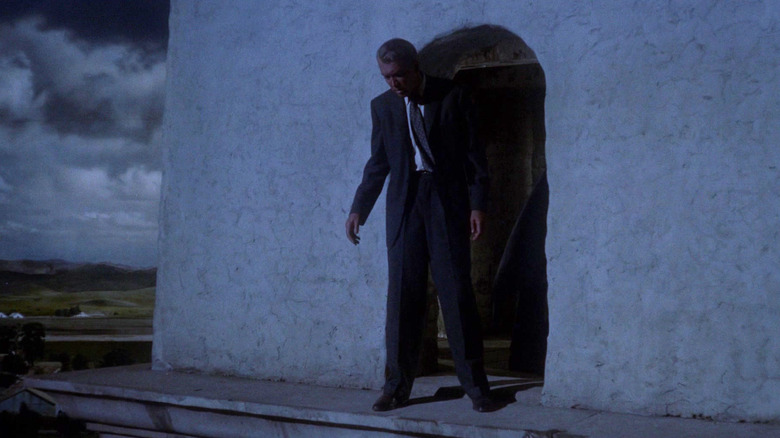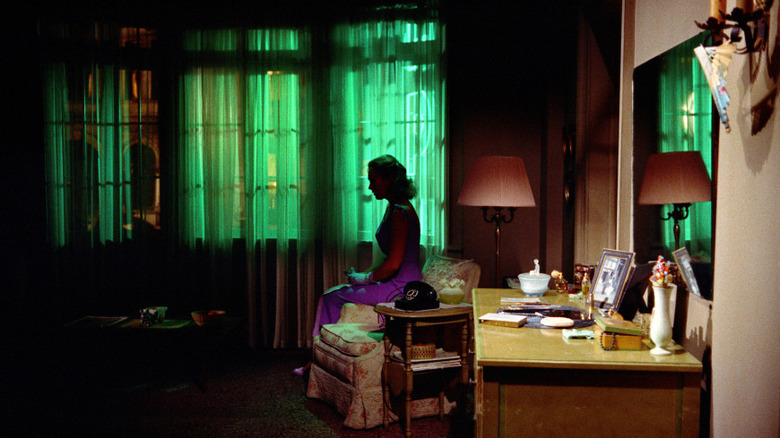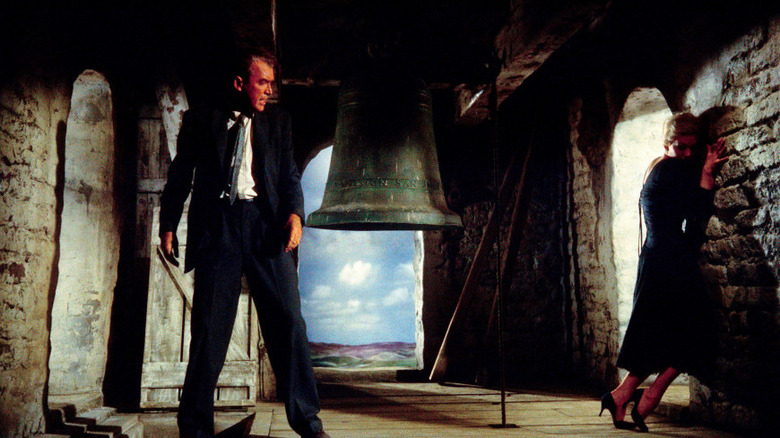How The Hays Code Almost Ruined The Ending Of Alfred Hitchcock's Vertigo
If you want to understand anything about cinema throughout the late '30s to the mid-'60s, first you have to know about the Hays Code. It was a self-imposed censorship for Hollywood studios, essentially forbidding movies from doing anything particularly "lewd" or controversial. Although there was already a list of "Don'ts" and "Be Carefuls" proposed in 1927 (which included restrictions on profanity, nudity, sexuality, and illegal drugs), it wasn't until 1934 that the studios were truly forced to take it all seriously.
The result was that, for decades, Hollywood was heavily restricted in its ability to deal with real-world social issues or portray its characters in an honest, non-sanitized way. Not only were a generation of movies creatively hindered, but there's been a subsequent widespread misremembering of the time period as being uniquely innocent and chaste. It's common for reactionary political figures to point back to the '50s as this time where everyone was straight, white, polite, and never had sex outside of marriage, but that period never actually existed; it's just how most of the movies were.
Even a director as popular as Alfred Hitchcock still had to bend the knee to the Hays Code most of the time, such as in his 1940 thriller "Rebecca" when he had to significantly alter one of the biggest plot twists of the book he was adapting. The twist would've featured a bad guy getting away with a horrible crime he'd committed; it was dramatically interesting, but it violated the rule that criminal actions in a movie needed to be punished by the end. 18 years later, the Hays Code would try to force Hitchcock to make another crime-related change to "Vertigo," but this time they weren't successful.
A quick recap
In the version of "Vertigo" we all know and love, the main character Scottie (James Stewart) falls in love with the woman he's been paid to investigate, Madeleine Elster. She dies unexpectedly about halfway through the movie, and Scottie then finds himself falling in love with Judy, another woman who looks and sounds exactly like Madeleine. Both are played by Kim Novak.
The movie then lets us in on the revelation that Scottie's been tricked from the very beginning: Madeleine's husband, Gavin Elster, had hired Scottie to investigate her as part of an elaborate murder scheme. The version of Madeleine Scottie fell in love with was actually Judy being paid to pretend to be her; while Scottie spends the second half of the film thinking he's miraculously found another woman who's exactly like Madeleine, we know he's actually falling in love with the same person all over again.
What complicates things further is that Judy, despite being complicit in a murder scheme and actively deceiving Scottie the whole time, still genuinely loves him and chooses to be with him despite the obvious risks involved. What follows is a dark and suspenseful series of events where Scottie grows increasingly obsessed with bringing out the "Madeleine" side of Judy. Things ratchet up even more when Scottie figures it out; he drives her over to the site of Madeleine's fake death, forces her up the tower, which inadvertently leads to her falling to her death, for real this time. It makes for an unsettling tale about guilt and obsession; it's not a happy ending by any stretch, but it's the type that sticks with you long after the credits roll. That's why, despite its initially mixed perception, "Vertigo" is now widely considered one of Hitchcock's best.
How it almost ended
The big issue the censors had with "Vertigo" was how Gavin Elster is never explicitly punished for murdering his wife, which is why the movie originally ended with a scene after Judy's climactic death. Whereas the finished movie ends with Scottie standing on the ledge by himself, with the subtle implication that he might jump, the alternate ending cuts to at least a few hours later.
There, we see his ex-fiancée Midge listening to the radio alone in her apartment, where the reporter's explaining how the authorities are currently hunting down Elster for his crimes and expect to be arresting him soon. She turns off the radio when she hears Scottie entering. The two don't speak a word, but Midge pours him a drink while he stares out the window at the night-time view of San Francisco. They drink in silence, and the movie ends.
It's not a happy ending either, but it's more conclusive than what we got. It provides a moment of reconciliation between Scottie and Midge — the two weren't fighting exactly, but their friendly rapport had definitely fractured as Scottie's obsession with Judy/Madeleine took hold of him. With Judy out of the picture, these final moments argue, maybe Scottie and Midge can get back to the way things were.
But the main purpose of the alternate ending is to assure viewers (or rather, the censors) that Elster would be punished for killing his wife. Even beyond the clunkiness that's always present when characters listen to conveniently-timed live news reports, this addition to the story feels awkward because the movie's never been about Elster. After nearly an hour of watching the drama between Scottie and Judy unfold, Elster had long since left the picture. Learning of his comeuppance wasn't necessary.
Why the original's better
Thanks to the gradual weakening of the Hays Code (which was abandoned entirely by 1968) as well as Hitchcock's sheer popularity by this point, the director was able to remove that final scene despite the Production Code Administration's wishes. It's a good thing he did, too, because as quick and harmless as the clip seems, it still undermines a lot of the haunting mood the movie's ending went for.
"Vertigo" is about obsession, after all, and that's why the final act of the film cuts out characters like Midge and Elster altogether. Midge was important in the first half because she helped give Scottie a sense of normalcy and stability; she was a platonic friend who made for a relationship that was a polar opposite of the intense, feverish romance between Scottie and Judy. Her absence in the second half is there to emphasize just how much Scottie's spiraling and how his life has become all about trying (and failing) to recapture his love with the original Madeleine.
The released film's ending, with Scottie standing over that ledge, is great not just because of how ambiguous it is, but because of how much it emphasizes his loneliness. There's a strong sense of "now what?" to those final moments. This is Scottie at rock bottom, having spent a significant period of time obsessing over a woman who technically never existed, and now he's left with no one in his life at all. To throw in another scene where Scott goes back to his normal life again would've undermined the incredibly evocative, tragic note the movie ended on. Hitchcock chose to let the movie end on its most striking note, censors be damned, and it was one of the wisest creative choices he ever made.


